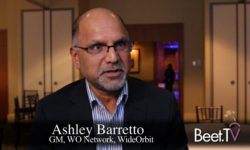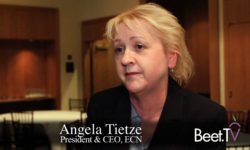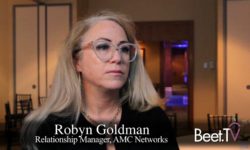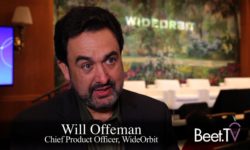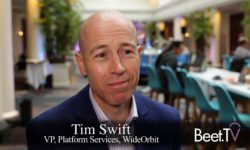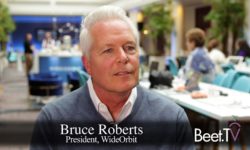SAN FRANCISCO – Lighthouses will soon be popping up all over the United States, but they won’t have anything to do with nautical navigation. The new facilities will bring to life ATSC 3.0, the Internet-protocol, over-the-air television transmission standard that will give broadcasters new ways of delivering and monetizing content.
“Think of this new platform like the Apple iOS platform where developers can come and develop new applications and services that can ride on top of our broadcast platform,” says Anne Schelle, Managing Director of Pearl TV.
We spoke to her after her keynote speech to hundreds of local TV and radio executives at the the WideOrbit Connect conference in San Francisco on Tuesday.
Washington-based Pearl TV was created by broadcasters to bring ATSC 3.0 to fruition, Schelle explains in this interview with Beet.TV at the WideOrbit Connect conference. Its members—Cox Media Group, the E.W. Scripps Company, Graham Media Group, Hearst Television Inc., Meredith Local Media Group, Nexstar Media Group, Raycom Media and TEGNA, Inc.—operate more than 220 network-affiliated TV stations.
Finalized by the Federal Communications Commission in January of 2018, ATSC 3.0 will be dependent on spectrum allocated by individual broadcasters for a consumer rollout set for late 2020. Now its various stakeholders need to agree not only on its infrastructure but also how to explain its attributes to consumers.
“We need to commercialize it,” says Schelle.
Pearl TV chose Phoenix as its test market, setting up one lighthouse station to emit signals under the new standard to kick off the transition from ATSC 1.0. “The trick will be to do that, we have to also maintain our 1.0 services. And we want to. That’s our bread and butter business as well as our multicast.”
Fox, NBC, Univision and PBS are collaborating on the test platform in Phoenix.
With a modernized user interface, ATSC 3.0 will provide free, live linear programing and a host of over-the-top streaming content.
One of the big payoffs for broadcasters is the viewership data they will be able to collect, fueling interactive TV and addressable advertising. “Broadcasters have never had access to their own data on their own channels,” notes Schelle.
The FCC made ATSC 3.0 voluntary as opposed to mandatory for broadcasters at the industry’s request, as CNET reports. It will be segmented into Designated Market Areas like current broadcast TV.
Initially, monetization ROI will come from viewer retention, data and advanced advertising. “It also will enable us to do data-informed sales,” Schelle adds.
The capabilities of ATSC 3.0 extend to the Internet of things, particularly smart vehicles. “This is a really economical pipe,” a one-to-many system with which “we can deliver at a fraction of the cost large data files, information, navigation, maps to connected cars and autonomous vehicles. That brings a whole new world to broadcasters.”
In the meantime, Pearl TV will be setting up consumer labs to explain the new technology, “what to call it” and how best to market the TV sets and other technology needed to make it happen.
This video is part of a Beet.TV series on advanced TV produced at the WideOrbit Connect conference. WideOrbit is the sponsor of this series. Please find more videos here.








